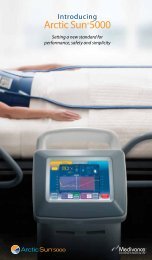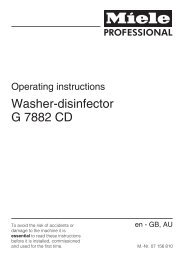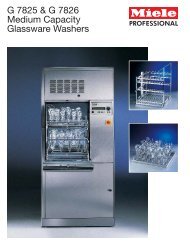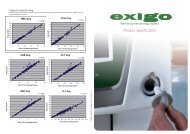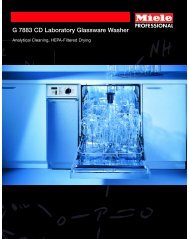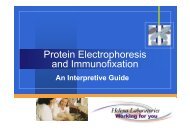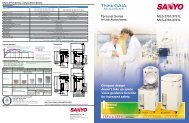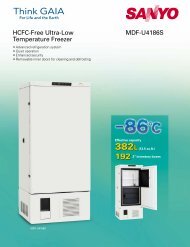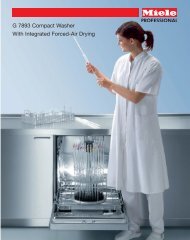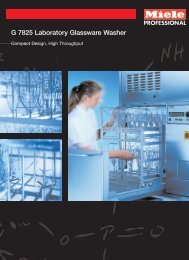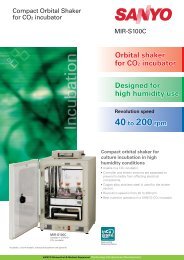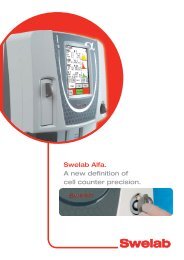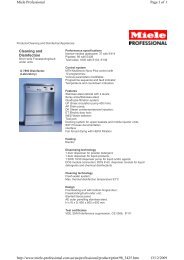G 7881 - Brochure - 2006 final.qxp
G 7881 - Brochure - 2006 final.qxp
G 7881 - Brochure - 2006 final.qxp
You also want an ePaper? Increase the reach of your titles
YUMPU automatically turns print PDFs into web optimized ePapers that Google loves.
Extensive Biological Testing Conducted to<br />
Prove Cleaning and Disinfection Capabilities<br />
Increasing the Microbial Challenge<br />
To consider the worst case scenario,<br />
these tests were conducted in two<br />
series: one series in which the<br />
instruments were processed in the Miele<br />
Dental Thermal Disinfector immediately<br />
after inoculation; in the second test<br />
series the instruments were dried for 6<br />
hours after inoculation with organisms<br />
and blood, but before processing.<br />
To further increase the challenge, part of<br />
the instruments were scratched both with<br />
a rotating metal brush and with a<br />
grinding stone. The resulting fine and<br />
deep scratches on the surface of the<br />
instruments are hard to clean and<br />
disinfect, and may provide a safe harbor<br />
for microorganisms. Nonetheless,<br />
scratched instruments are commonly<br />
used in practice.<br />
Mycobacterium Tuberculosis<br />
Infections with tuberculosis have been<br />
spreading again in the United States during<br />
the last few years. For this reason, special<br />
emphasis was laid upon the disinfection<br />
abilities regarding this organism.<br />
Hinged, hollow, and hand instruments were<br />
inoculated with the Mycobacterium<br />
tuberculosis, strain ATCC 25177, and blood.<br />
The estimated microbial load was 10 8<br />
organisms per instrument. Three hinged, 3<br />
hollow, and 6 hand instruments constituted<br />
one test load. Both test series with and<br />
without drying were conducted.<br />
The results showed that no live organisms<br />
were present after the disinfection cycle,<br />
indicating a log-reduction factor of at least<br />
8. Tuberculocidal action was proved.<br />
Pseudomonas Aeruginosa<br />
Salmonella Choleraesuis<br />
Staphylococcus Aureus<br />
Tests on these bacteria are required for<br />
disinfectants. These bacteria were tested<br />
for in the Miele Dental Thermal<br />
Disinfector even with the elevated<br />
challenge of 6 hours drying and<br />
scratched instruments. The inoculum<br />
also contained blood and hydroxyapatite<br />
to simulate tooth material.<br />
In most cases no organisms could be<br />
recultured, indicating that usually each<br />
and every organism was killed.<br />
Enterococcus Faecium<br />
The bacterium E. faecium, ATCC 49224,<br />
was tested in a similar fashion as the<br />
Mycobacterium tuberculosis.<br />
In no cases could any organisms be<br />
recultured. A log-reduction factor of at<br />
least 8 was proved.<br />
Hepatitis B Virus<br />
The HBV cannot be artificially cultured.<br />
Hence, the direct testing of the HBV is<br />
not feasible. However, the Enterococcus<br />
faecium possesses similar heat<br />
resistance properties as the HBV*. E.g.<br />
the German Federal Health Authority<br />
accepts the testing of E. faecium as a<br />
replacement for HBV**.<br />
The Miele Dental Thermal Disinfector<br />
achieves a log-reduction factor of at least<br />
8 for E. faecium.<br />
HIV<br />
The Human Immunodeficiency Virus (HIV)<br />
causing the Acquired Immunodeficiency<br />
Syndrome (AIDS) is very unstable in the<br />
presence of heat. An American study<br />
shows that HIV is reduced to 1/10<br />
at 60°C/140°F after 24 seconds***. After<br />
10 minutes at this temperature a<br />
log-reduction factor of 25 is achieved. That<br />
means that from 10 25 HI viruses it is likely<br />
for 1 virus to survive.<br />
The Miele Dental Thermal Disinfector<br />
reaches a temperature of 93°C/200°F<br />
and holds it for 10 minutes. Therefore it is<br />
safe to assume that HIV will be reduced<br />
according to a high-level disinfection<br />
standard. For this reason the HIV was not<br />
specifically tested for with this system.<br />
Proven Cleaning Abilities<br />
A wide range of cleaning studies have<br />
been conducted utilizing common<br />
dental instruments.<br />
One study was conducted with fresh<br />
human blood. This blood was not<br />
defibrinated so that it would clot after a<br />
short time. This certainly represents the<br />
most realistic testing possible. Two test<br />
series were conducted both with<br />
immediate cleaning and with cleaning after<br />
a drying time of 6 hours. Both new and<br />
scratched instruments were utilized.<br />
After completion of the cleaning and<br />
disinfection cycle the instruments were<br />
tested for traces of blood residues with<br />
Hemastix. In most cases no blood<br />
residues could be found. In very few cases<br />
residues could be traced in hinges of<br />
hemostats. However, these residues were<br />
close to the detection limit of the test.<br />
Other cleaning tests that were conducted<br />
affirmed the claims of this brochure:<br />
Orthodontic and surgical instruments<br />
taken from actual patient use, dental<br />
instruments inoculated with sheep blood<br />
and hydroxyapatite, and instruments<br />
contaminated with dental cement.<br />
Disinfection Parameters<br />
93°C/200°F/10 min.<br />
The thermal disinfection process relies<br />
upon the two physical parameters<br />
temperature (93°C/200°F, accuracy:<br />
+4°C/7.2°F -2°C/3.6°F) and time (10 min.).<br />
The Miele Dental Thermal Disinfector<br />
strictly adhered to these parameters<br />
throughout the wash cabinet, even fully<br />
loaded. No cold spots could be detected.<br />
*G. Spicher: Zur Desinfektion bei Virushepatitis,<br />
in: German Federal Health, Authority leaflet ”Bundesgesundheitsblatt”,<br />
Vol. 22, 1979, No. 617, pp. 114–116.<br />
** G. Spicher, J. Peters: Richtlinie des Bundesgesundheitsamtes<br />
zur Prüfung von thermischen Desinfektionsverfahren,<br />
in: lbid, Vol. 23, 1980, No. 23, pp. 364–367.<br />
*** J. S. McDougal, L. S. Martin, S. P. Cort, M. Mozen, C. M.<br />
Heldebrant, B. L. Evatt: Thermal Inactivation of the Acquired<br />
Immunodeficiency Syndrome Virus, Human T Lymphotropic<br />
Virus-III/Lymphadenopathy-associated Virus, with<br />
Special Reference to Antihemophilic Factor, in: The Journal<br />
of Clinical Investigation, Inc., Vol. 76, August 1985,<br />
pp. 875–877<br />
9



